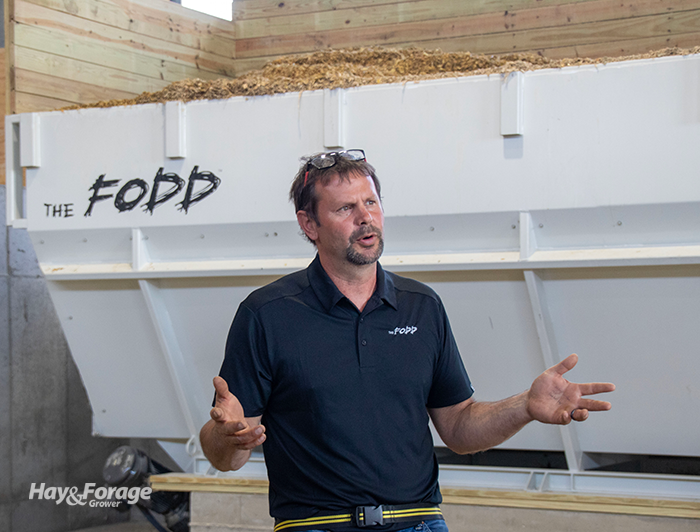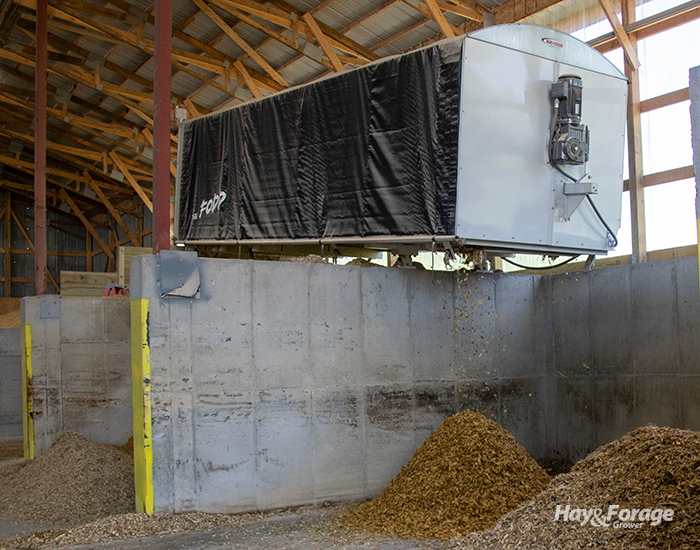
Whether farmers raise dairy cattle, beef cattle, or any other type of livestock, one thing they all have in common is that they must manage variability — variability in weather, variability in market prices, and variability in feed costs and quality.
It was the latter issue — specifically expensive, poor-quality straw — that inspired Greg Friendshuh to build a corn silage separation system and capitalize on the starch and fiber content of his least expensive feed ingredient. The machine coined “The Fodd” separates short corn silage particles, or “fines,” and coarse particles, or “fodd,” for lactating cow rations and dry cow and heifer rations, respectively.
The Fodd system consists of a hopper that is connected to a rolling trommel. Paddles inside the rotating cylinder pick up and drop corn silage to sort it, with about two-thirds of the material falling through a 5/8-inch screen as fines and the rest of the fodd moving out the tail end. Fines contain about 42% starch and 30% neutral detergent fiber (NDF), whereas fodd has 20% starch or less and approximately 47% NDF.
After four years of using The Fodd on his 1,200-head dairy farm near Clear Lake, Wis., Friendshuh has realized greater ration consistency, an uptick in milk components, better average daily feed intake, and noticeable improvements in animal health. He conservatively estimates that using The Fodd has enhanced profitability by about $300 per cow per year between lower feed costs and greater production.

Last month, Friendshuh unveiled the latest version of his invention: The Fodd 3.0. This version can sort about 12 tons of corn silage per hour, is powered by an electric motor rather than diesel, and it includes features like a self-cleaning system and automatic start-up and shut-off.
With these upgrades and the ongoing success of The Fodd on his home farm, Friendshuh has turned his focus toward manufacturing machines for other Wisconsin dairymen and eventually marketing them across the country. Despite some minor setbacks with on-farm installation and reformulating rations to account for fines and fodd, he anticipates the biggest challenge will be convincing others to embrace a new way of thinking about corn silage.
Consistency and uniformity
At The Fodd 3.0 unveiling, Jim Smith, a strategic account manager with Pioneer Seed, stated that the growing environment has three times more influence on corn silage NDF digestibility (NDFD) than hybrid genetics. He added that the amount of moisture and the timing at which a corn plant receives it can have a seven-fold effect on NDFD. Therefore, silage quality is subject to significant variability from field to field and from year to year.
There is no way to control the effects of the weather, but Smith suggested separating fines from fodd essentially equalizes NDFD, and thus, silage quality. This enables more consistent inclusion rates and better nutrition for all cows, at all times, regardless of growing season conditions.
“You can’t afford to get stuck with a bad year of corn silage because it gets expensive from a cow health standpoint, a milk production standpoint, or a feed costs standpoint,” Smith said. “Managing variability is the key to this machine.”
Also at the unveiling, Keith Sather explained that in addition to combatting challenging crop years, separating fodd from fines eliminates NDFD variation that can occur within storage piles. The dairy nutrition consultant said the greater the fluctuation in silage quality, the more effective The Fodd will be at maintaining ration uniformity.
“Maybe corn silage gets too dry and the digestibility of the fiber starts to drop off. When you harvest out the fines, what you are doing is increasing NDF digestibility of the feed that is going to the lactating cows,” Sather said. “The more undigestible the feed is, the bigger impact you are going to see on the spread of digestibility from the fodd to the fines.”
This simultaneously offers control over starch. For example, by including fines with unseparated corn silage in a lactating cow ration, Sather was able to improve starch content from 32% to 38% without adding other sources of grain or protein to balance the diet like he must do for other dairies.
“Last year, we had some really tough growing conditions in some areas, and I’m feeding some corn silage on farms that is 28% starch,” Keith said. “If I had The Fodd machine, I could boost the starch content of that corn silage so much easier.”
Milkfat and protein
Tim Swenson, a dairy production and management consultant, also offered insight on the economic benefits of The Fodd. He shared that out of all the farmers he works with, about one-third were profitable in 2023, one-third broke even, and one-third lost money on their dairies.
“The difference wasn’t on the expense side; it wasn’t whether they did a decent job of marketing. It was how many pounds of fat and protein they shipped,” Swenson said of his clients. “We really need to drive those numbers and take advantage of them.”
Since Friendshuh started adding fines to his lactating cow ration — which also contains unseparated dual-purpose corn silage and alfalfa haylage — milk production has climbed about 2 pounds per cow per day. He contends that these cows are not necessarily eating more, but rather making better use of the energy in their diet, proven by the highest feed efficiency over energy corrected milk his farm has recorded to date.
With that said, dry cow and heifer feed intakes have improved, largely due to the fact that animals cannot sort fodd like they used to sort straw. Eliminating straw and other ingredients from animal diets has alleviated some stress from a labor standpoint, too. Even though Friendshuh is growing about 25% more corn than he was before inventing The Fodd, he doesn’t handle straw bales or maintain smaller piles of alternative forages that he previously needed to balance diets.

Opening doors
Poor-quality straw inspired The Fodd, but Swenson said the machine can resolve other on-farm pain points as well. He believes identifying those problems will generate interest among other farmers, whether they are facing extreme feed prices, variable silage quality, ration inconsistencies, or a shortage of time and labor.
“Farmers may be so engrained in their current system that they can’t see where the value in The Fodd is. Part of overcoming that is to have a point of adversity,” Swenson said. “If you have a point of adversity, you look for a solution, and you will be willing to make a change.”
Friendshuh’s initial goal for The Fodd is to introduce it on farms in all four corners of the Badger State. Considering feed cost savings, herd size, and milk production, he said the machine has potential to pay for itself within one to two years. Friendshuh anticipates other installation costs for The Fodd will be minimal, especially if it can be housed in an existing building, like a commodity shed.
“The Fodd has simplified our dairy, streamlined our operations, and made it a more robust system,” Friendshuh said. The humble dairyman hopes the same will come true for other farmers who implement The Fodd, and that the machine not only enhances the quality of their feed, but also the quality of their lives.
For more information about The Fodd, visit www.thefodd.com.

